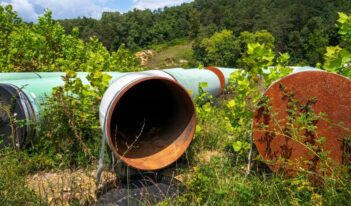
The Supreme Court narrows NEPA, leaving key questions unresolved.
The U.S. Supreme Court’s opinion in Seven County Infrastructure Coalition v. Eagle County, Colorado contains an important insight about environmental reviews under the National Environmental Policy Act of 1969 (NEPA): The scope of such reviews should ultimately be driven by the agency’s obligation to consider environmental issues in its decision-making.
Unfortunately, writing for the majority, Justice Brett Kavanaugh failed to fully recognize the significance of this point, which Justice Sonia Sotomayor more fully unpacked in her concurring opinion. As a result, the Court’s opinion is likely only to add further confusion to an already perplexing area of law. The Court’s opinion also makes explicit what observers had long believed: that the Court views NEPA as a second-class law, subject to only grudging judicial enforcement.
Seven County involved the federal approval of a new rail line that would connect oil producers in Utah’s Uinta Basin with refineries via the national rail network. When a project like the rail line has significant environmental impacts, NEPA requires a “detailed statement” that discusses the project’s negative environmental effects and reasonable alternatives. The issue before the Court was whether the resulting drilling and refinery processing, which would have significant environmental consequences, had to be discussed in the project’s environmental impact statement required by NEPA. The Court held that the lower court should have deferred to the agency, which had found those impacts too remotely connected to the proposed railway line to require consideration.
Justice Kavanaugh’s majority opinion features a lengthy excursion into what might be called “NEPA negativism”—a view of the statute as primarily a source of unnecessary friction in project approval. That negativism comes as no surprise. In over 50 years, the Court has yet to uphold a NEPA claim. But, until Seven County, the Court has never been quite so forthright about its disdain for the statute. Unlike previous opinions, Justice Kavanaugh did not make any reference to possible benefits of the statute in forcing agencies to be more attentive to the environment. He called for extra deference toward agency implementation of NEPA, beyond the deference agencies normally receive, while decrying the potential for delays and project cancellations due to NEPA. Kavanaugh cited no evidence in support of his critique, and the empirical evidence on whether NEPA procedures contribute to delays is actually mixed.
Having set the bar low for the agency, Justice Kavanaugh then presented his main argument: The railroad line should not be considered the proximate cause or the “legally relevant” cause of the upstream drilling or downstream air pollution. In previous cases, the Court had referred to the concept of proximate cause in tort law as an analogy in determining what environmental effects of a project should be considered, while stressing that the analogy was incomplete. It had also used the term “legally relevant” to refer to effects that an agency was legally entitled to consider in passing on a project.
Justice Kavanaugh used these terms more as a way of expressing conclusions than fostering analysis. His main argument for dismissing the effects of drilling or expanded refinery operation seemed to be that other agencies regulate these activities, combined with their physical distance from the new track. Those agencies’ approval processes, Justice Kavanaugh reasoned, break “the chain of proximate causation” between the railroad track and the resulting environmental damage from expanded drilling and refinery use. He did not, however, consider whether in other contexts such as tort law the chain of causation would be considered broken merely because another actor was involved in causing the effects. Nor did he explain what in the law governing approval of the line required the agency to disregard foreseeable effects simply because they were regulated by other agencies. Indeed, the agency did not find the causal chain difficult to follow in assessing the benefits of the project, which promised to bring an oil boom to the Unita Basin.
In his analysis, Justice Kavanaugh again seemed to be engaging in “NEPA negativism,” treating causation more narrowly here than in other areas of the law. For example, in order to bring a case, a party must show that it has standing, which requires showing that it has suffered an injury caused by and “fairly traceable” to the defendant’s action. The Court would readily find standing if the agency had rejected the project and had been sued by owners of oil rights in the basin. It would surely have found the injury to the owners of the oil rights “fairly traceable” to cancellation of the railroad project for standing purposes.
Indeed, in a standing opinion authored by Justice Kavanaugh around the same time as Seven County, the Court suggested that the refineries would also have had standing to challenge the disapproval of the rail line. Yet the same chains of causation the Court deemed sufficient for standing are treated as insufficient under NEPA. What is a “fairly traceable” chain of causation for standing purposes seems to be only a jumble of broken links under NEPA, which belies Justice Kavanaugh’s confidence in the obviousness of his conclusions in the Seven County case.
Justice Kavanaugh’s opinion is likely to cause further confusion in NEPA law. Implementation of the statute is already in turmoil for two other reasons. First, Congress enacted extensive amendments to the statute that are something of a drafting disaster, as I discussed at length in an article. Second, President Donald J. Trump eliminated regulations by the Council on Environmental Quality that had played key role in coordinating agency implementation of NEPA and guiding courts. Justice Kavanaugh’s garbled discussion of proximate cause will not help matters.
Nearly any torts student would agree that proximate cause is a notoriously slippery concept, one that provides little guidance in deciding specific cases. Justice Kavanaugh emphasized that the other “projects” in question—oil drilling and refinery operation—were regulated by other agencies, but he stopped short of making that completely decisive. He also failed to explain what level of involvement by other agencies is needed, which activities qualify as “projects,” whether state agencies qualify, and whether his discussion of NEPA deference would require a court to uphold an agency that did want to consider the impacts.
As I said at the outset, Justice Kavanaugh’s majority opinion touches on the key to straightening out NEPA jurisprudence, but he moves too quickly in other directions. That key point was that the validity of the environmental impact statement “is relevant only to the question of whether an agency’s final decision—here, to approve the railroad project—was reasonably explained.” It is a pity that Justice Kavanaugh did not stop to ponder this point. The implication is that NEPA issues should not be considered in the abstract; instead, they should be considered as closely connected with an agency’s duty to consider environmental factors in its ultimate decision.
Seven County would have been the perfect vehicle for the Court to explore this insight. There was no daylight between the environmental impact statement and the agency’s decision on the merits in this case. As the U.S. Court of Appeals for the D.C. Circuit pointed out in the decision reviewed in Seven County, the agency adopted its impact statement as the environmental portion of its decision to approve the project. Furthermore, the D.C. Circuit held the decision approving the rail line to be arbitrary and capricious under the “public interest” standard in the operative statute, for the same reasons it found the impact statement insufficient. Applying special rules to the impact statement misses the larger point.
As Eric Biber and I argue in a recent article, recognizing this insight would do much to straighten out NEPA jurisprudence. The basic test for whether an environmental effect needs to be discussed in an impact statement should be whether it would be arbitrary or capricious for the agency to ignore it in making its decision on the merits. This test would not resolve every issue—we discuss some remaining complications—but it would greatly simplify the inquiry.
This insight should also explode the basis for “NEPA negativism.” Whether the impacts of increased oil drilling must be discussed in the agency’s decision on the merits involves the statute governing the agency’s decision, not of NEPA standing alone. That ultimate agency decision, including its consideration of environmental factors, is subject to the normal level of judicial review, not a special diluted standard of review that applies only to NEPA. Excluding a topic from an impact statement may have some procedural implications in terms of administrative processes and public notice, but it makes little ultimate difference if the agency must discuss it in its project decision anyway.
In short, the impact statement is merely an aid to the agency in making its ultimate decision. Thus, we need to start by interpreting the operative statute and work backwards to consider what topics must be part of the impact statement. Unfortunately, although the concurrence got this right, the majority seems to have lost track of this fundamental point.
This essay is part of a series, titled “The Supreme Court’s 2024-2025 Regulatory Term.”




